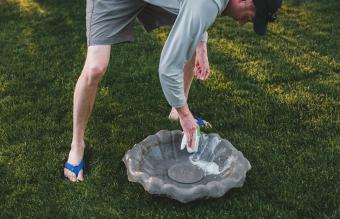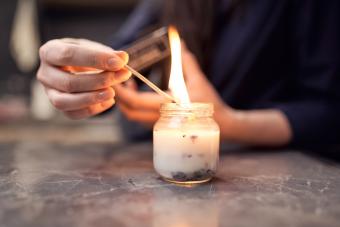
Bird baths are lovely additions to gardens and landscapes, keeping your feathered friends clean and refreshed on hot days. Daily use and the elements cause them to get dirty, but with regular cleaning and maintenance, your bird bath will stay in great shape.
You can use common household products to clean even the nastiest bird baths. These methods can be used on bird baths made of most standard materials like concrete, terracotta, plastic, and ceramic-glazed baths. Though it may not top your household chore list, knowing how to safely clean and maintain a bird bath is important. Discover some of the best ways to clean a bird bath and learn how to keep birds happy and healthy!
Easy Ways to Clean a Concrete or Other Type of Bird Bath
The methods listed below work on both concrete and most typical types of bird baths. The first thing to do before cleaning a concrete bird bath is to remove the water it's filled with. You can then choose which option you prefer to clean it, whether you use simple, natural methods or want to use something stronger for a deeper clean. Assess the area to decide the best way for you. Choose a technique based on how dirty the area has become, whether there are stains that need treating, and what process you feel most comfortable using. The safest approaches include water, vinegar, and baking soda.
How to Keep a Bird Bath Clean Naturally With Water
A cleanser isn't needed for the majority of bird bath cleanings as long as you regularly clean it. According to The National Wildlife Federation (NWF), you can clean a bird bath with just water and a stiff bristle brush. Another option is to use a power washer with water and a jet nozzle, which is a fast, safe cleaning process. The NWF also advises changing out the water on a regular basis to prevent the water from becoming stagnant, as this creates conditions for bacteria and algae to grow in your bird bath.
The National Audubon Society warns against using detergents to clean a bird bath. Science Direct explains that detergent can strip the bird's natural oils excreted from the preen gland (uropygial gland). The oils from this gland coat the feathers to provide antimicrobial protection from bacteria, ectoparasites, and fungi. The oil also waterproofs the feathers. When the oil is stripped from the feathers, the bird becomes vulnerable to these, and disease can set in.
How to Clean a Bird Bath With Vinegar
The National Audubon Society suggests using distilled white vinegar to clean a bird bath safely. This is a simple and safe method that won't harm birds or other wildlife. The recommended mix is 9:1 of water: distilled white vinegar. However, some birding organizations, such as Ottawa Valley Wild Bird Care Centre, report cleaning a bird bath with vinegar works best when using a 1:1 ratio of water and distilled white vinegar.

Supplies Needed
- Clean water via garden hose or water bucket
- Distilled white vinegar
- Bottle or bowl
- Stiff bristle scrub brush
Instructions
- Pour out any water in the bird bath.
- Mix nine parts of water to one part distilled white vinegar in a bottle or bowl.
- Pour mixed water and vinegar into the bird bath.
- Scrub the bird bath with the brush until all debris is loosened.
- Pour out the vinegar (works great as a weed killer).
- Rinse with clean water using a garden hose or water bucket.
- Rinse scrub brush.
- Use scrub brush over bird bath to ensure all dirt is removed.
- Rinse bird bath and brush.
- Allow bird bath to dry and then fill with fresh clean water.
- Keep the scrub brush handy and only use it for cleaning the bird bath.
How to Clean a Bird Bath With Baking Soda to Remove Stains
You can use another harmless ingredient to remove stubborn stains from your bird bath. Common baking soda can lift the darkest and ugliest stains, and it won't hurt the birds. Here is what you'll need to clean a bird bath with baking soda.
Supplies Needed
- Stiff bristle scrub brush
- Baking soda
- Clean water from a garden hose or bucket
Instructions
- Empty the current water in the bird bath.
- Rinse with a garden hose or bucket of clean water.
- Empty rinse water.
- Sprinkle baking soda over the bird bath basin.
- Sprinkle a little water over the baking soda, enough to form a paste.
- Use the scrub brush and work in circular motions.
- Scrub the entire basin.
- Rinse the bird bath and scrub brush.
- Empty the water and soda solution.
- Rinse the bird bath a second time.
- Empty the water and check to make sure all the baking powder is gone.
- Rinse again if necessary.
- Refill the bird bath with clean water.
Cleaning a Bird Bath With Peroxide
You can also use hydrogen peroxide to clean your bird bath. Use a 1:1 ratio of water and hydrogen peroxide. Once you have the mixture ready, follow the same instructions as the vinegar method using the proper scrubbing technique and making sure you rinse it well. To combat stains, you can also allow the peroxide mixture to sit in the bird bath prior to scrubbing and rinsing.

Using Bleach to Clean a Bird Bath
Some people do use bleach to clean their bird baths since it can eat away at debris and stains. If you feel this is the method you want to use, make sure to thoroughly rinse all residue from the bird bath until most of the smell is gone before refilling for the birds' enjoyment.
Is It Safe to Put Bleach in a Bird Bath?
You can use bleach safely in laundry, what about a bird bath? According to the National Audubon Society, you don't need to use bleach to clean a bird bath since options such as distilled white vinegar will do the job. Rinsing all chemical residue requires multiple rinses, and you can still leave harmful bleach behind. In addition, some people report finding a dead bird or two after using bleach to clean their bird baths. Most people decide it isn't worth the risk when they can clean a bird bath with distilled white vinegar without harming or potentially killing birds and other wildlife. Any of the methods above are suitable alternatives for cleaning a bird bath without bleach.
How to Use Bleach to Clean a Bird Bath
If you intend to use bleach to clean your bird bath, make sure the bird bath material won't be damaged by bleach if it is made of something other than concrete. It is not recommended to use bleach with ceramic materials.
Supplies Needed
- Bleach
- Stiff bristle scrub brush
- Heavy duty rubber gloves
- Fresh, clean water and garden hose or water bucket
- Tarp, plastic sheet, or large garbage bag to cover bird bath to keep birds out
Instructions
- Empty the current water in the bird bath.
- Using the stiff bristle scrub brush scrub the bird bath.
- Dilute the bleach with water in a 9:1 ratio with water being the largest part.
- Pour the water/bleach solution into the empty bird bath.
- Fill the solution to the rim of the bird bath.
- Cover the bird bath with plastic sheeting, tarp, or a garbage bag, anchored around the rim so the wind won't carry it off.
- Leave the covering for as long as you want, depending on how much stain and dirt needs to be removed.
- Once the time is up, use the scrub brush to loosen any remaining dirt/stain.
- When you're satisfied all the dirt/debris has been removed, pour out the bleach mixture and loosened dirt.
- Make sure you dispose of this harmful chemical in a glass container or metal bucket to dispose of it properly.
- Use a garden hose or water bucket to rinse the residue from the bird bath with clean water.
- Again, be careful how you dispose of the liquid.
- Rinse more than one time.
- Allow the bird bath to dry naturally in sunlight.
- Wait a couple of hours before refilling to allow the sun to burn off any bleach residue.
- Refill the bird bath with clean fresh water.
Keep a Bird Bath Clean With Maintenance and Algae Control
You can create less work for yourself by incorporating regular bird bath maintenance. If you don't remedy the circumstances responsible for algae, scum, or bugs, you will have to repeat your deep cleaning efforts more often.. Here are some helpful tips for how to keep algae out of your bird bath and maintain its cleanliness.

- Put copper pennies that were minted prior to 1982 in your bird bath. The chemical reaction copper will stunt the growth of algae.
- Most types of algae tend to grow faster in the sun. Keep your bird bath in a shady area for better algae control and to keep your bird bath from turning green.
- Add 1 tsp of apple cider vinegar per 1 gallon of water in your bird bath. This creates a more acidic environment that makes it harder for algae and bacteria to live, but it is still safe for the birds.
- Keep the bird bath water clean by changing it once a week. This will prevent disease, algae, and mosquitoes from taking over the bird bath. If your bird bath attracts a lot of birds, you may need to empty out old water and replace it with clean fresh water every two to three days.
- Make sure you pay special attention to your bird bath's cleaning schedule during the warm time of year when birds are most likely to use it.
- Consistently scrub away bird droppings to prevent buildup in your bird bath. Seeds and bird droppings can carry various bird diseases that can be transmitted to other birds.
How to Clean a Bird Bath Easily
Choose a method for cleaning a dirty bird bath that best fits your preferences. You only need a brush and water for regular cleanings to prevent the dirt and scum buildup from returning, so you can tackle this outdoor cleaning chore with ease. Natural methods are best when cleaning your bird bath, but with proper technique and effective rinsing, any of these methods can be done safely. You'll love observing the different birds as they visit your bird bath, and they'll thank you for providing a clean place for them to freshen up and cool off.







